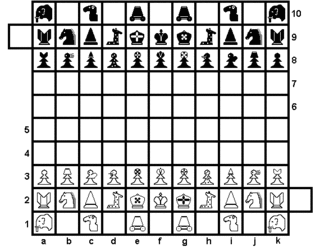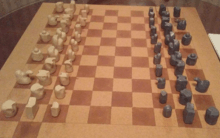Tamerlane chess

Tamerlane chess is a strategy board game related to chess and derived from chaturanga. It was developed in Persia during the reign of Timur (Timur's Chess), also called Tamerlane (1336–1405). Some sources attribute the game's invention to Timur,[1] but this is by no means certain. Because Tamerlane chess is a larger variant of chaturanga, it is also called Shatranj Kamil (Perfect Chess) or Shatranj Al-Kabir (Large Chess or Great Chess), as opposed to ash-shaghir ("Small Chess"). It is distinctive in that there are varieties of pawn, each of which promotes in its own way.
Board
A Tamerlane chessboard is made up of 110 uncheckered squares arranged in a 10×11 pattern ("camp"). Additional squares, known as citadels, protrude from the left side on the ninth row and from the right side on the second row, making a total of 112 squares.[1][2] When the opposing king occupies a player's citadel, the game is declared a draw. No piece other than a king may occupy a citadel.
There are several ways for an opening setup to be arranged. A common one is as follows:
- White's side (bottom row, from the left): elephant, (space), camel, (space), war machine, (space), war machine, (space), camel, (space), elephant.
- Second row (from the left): rook, knight, picket, giraffe, general, king, vizir, giraffe, picket, knight, rook.
- Third row (from the left): pawn of pawns, pawn of war engines, pawn of camels, pawn of elephants, pawn of generals, pawn of kings, pawn of vizirs, pawn of giraffes, pawn of pickets, pawn of knights, pawn of rooks.
Black's side mirrors White's.

Pieces
Anglicised versions of piece names are used here.
- king – Moves as a traditional king, but once during the game it may switch places with any of its own pieces to evade check/checkmate or stalemate.
- general – Moves one square diagonally
- vizir (vizier/governor) – Moves one square horizontally or vertically
- giraffe (zurafa) – Moves one square diagonally and then a minimum of three squares horizontally or vertically (a restricted gryphon)
- picket (tali'a)[3] – Moves as a bishop in traditional chess, but must move a minimum of two squares
- knight (Faras) – Moves as a knight in traditional chess
- rook (rukh) – Moves as a rook in traditional chess
- elephant (Pil) – Moves two squares diagonally and is unobstructed by pieces in between
- camel (jamal/shutur) – Moves one diagonally and two straight, unobstructed by pieces in between
- war engine (dabbaba) – Moves two horizontally or vertically, unobstructed by pieces in between
- pawns – Move as pawns in traditional chess, but with no initial double move or en passant capture. Every piece (including the pawn) has a corresponding pawn. Hence; pawn of kings, pawn of vizirs, pawn of giraffes, etc.

Rules
Beginning The Game
The player going first is determined by a roll of dice.
The Object
The object of Tamerlane chess, as in modern chess, is to checkmate the opposing shah [King]. A difference being that unlike in modern chess, stalemating an opponent is also a win.
Promotion
Upon reaching the last rank on the board, a pawn is promoted to its corresponding piece. Thus, the Pawn of Giraffes becomes a Giraffe, etc. Exceptions to this are the Pawn of Kings and Pawn of Pawns. A Pawn of Kings becomes a Prince. It moves as a king. If both a Prince and a King exist simultaneously on the board, one of the two must be captured [like a regular piece] before the other can be checked/checkmated or stalemated to win the game.(This idea of allowing multiple kings on each side through promotion was coincidentally also invented about a century earlier in Japan in the game of dai shogi.)
When the Pawn of Pawns reaches the last rank, it stays there and cannot be taken. As soon as a situation develops where the opponent cannot escape losing a piece to a pawn, or where a pawn may attack two opposing units at the same time [forked], the player must move his/her pawn to that location. It moves to this location even if the square is occupied, either by an allied or opposing piece. The piece occupying the square is removed from the board. On the pawns next move, it may capture any piece it is attacking. In then continues forward on the board as a pawn. Upon the second promotion of this pawn, it moves to the starting point of the Pawn of Kings. Upon the third promotion it becomes an adventitious king, which has the moves of the King, with one special exception as described in the next section. If an adventitious king exists on the board simultaneously with a Prince and/or a King, they must be captured like a regular piece until only one remains, which must then be checkmated or stalemated to win. [4]
The citadels
The two extra squares that protrude from the left of the ninth rank and the right of the second rank are called Citadels [husun, singluar hisn]. If, at any time during the game a player can move his King into his opponent's citadel, he can declare the game a draw. This is advantageous for a losing player as being stalemated is considered a loss in Tamerlane chess. Alternatively, if a player has a Prince or Adventitious King on the board when his Shah enters his opponent's citadel, his Shah can trade places with either of those pieces, and the game continues. The Prince or Adventitious King can later move out of the citadel to make way for the King to enter again, but the exchange privilege may only be used once.
The Shah [King] ranks higher than the Prince, which ranks higher than the Adventitious King. Only the highest ranking of the three on the board can enter the opponent's citadel.
The Adventitious King has the special honor of being the only piece on the board that can enter his OWN citadel. Upon entering, it becomes immune, thus blocking the opponent from entering the citadel and declaring a draw. [5]
Other
Once during the game a player may exchange a checked king for another non-royal piece. A player may move into check if he holds multiple kings. There is no castling or en passant moves in Tamerlane chess. Baring the opponent's king is not considered a win in Tamerlane chess, as the bared King still has the chance to enter the opponent's citadel. There is no three-fold repetition or 50 move draw in Tamerlane chess.
Tamerlane Chess Club
A public chess club in Jamestown, NY, named Tamerlane Chess Club, is dedicated to this game as well as other Ancient Chess Variants.[6] [7]
References
- 1 2 Cazaux, Jean-Louis and Knowlton, Rick (2017). A World of Chess, p.31. McFarland. ISBN 9780786494279. "Often known as Tamerlane chess, [its invention] is traditionally attributed to the conqueror himself."
- ↑ Falkener, Edward (1892). Games Ancient and Oriental, p.. Longmans, Green and Company. [ISBN unspecified].
- ↑ Cazaux and Knowlton (2017), p.360, n.21. "Tali'a means scout, vanguard, outpost, picket, advanced post, spy, a group of soldiers or troops placed on a line forward of a position to warn against an enemy advance."
- ↑ John Gollon, Chess Variants, Ancient, Regional and Modern, pp76-77
- ↑ H.J.R. Murray, "History of Chess", 1913
- ↑ https://www.facebook.com/Tamerlane-Chess-Club-1011010045713056/?view_public_for=1011010045713056
- ↑ http://www.uschess.org/msa/AffDtlMain.php?A6052321
Further reading
- Falkener, Edward (1961) [1892]. "XVI. Tamerlane's Chess". Games Ancient and Oriental and How to Play Them. Dover Publications Inc. pp. 197–216. ISBN 0-486-20739-0.
- Gollon, John (1973). Chess Variations: Ancient, Regional, and Modern. Charles E. Tuttle Company Inc. ISBN 0-8048-1122-9.
- Pritchard, D. B. (1994). "Timur's Great Chess". The Encyclopedia of Chess Variants. Games & Puzzles Publications. pp. 314–15. ISBN 0-9524142-0-1.
- Pritchard, D. B. (2007). "Timur's Great Chess". In Beasley, John. The Classified Encyclopedia of Chess Variants. John Beasley. pp. 270–71. ISBN 978-0-9555168-0-1.
External links
- Tamerlane chess by Hans Bodlaender at The Chess Variant Pages
- Rudolph, Jess; ed. "Tamerlane Chess - Timur's Chess", CWRUMS at the Wayback Machine (archived 8 February 2012)
- Cazaux, Jean-Louis (28/09/2012). "Tamerlane Chess", History.Chess.Free.Fr.
- Tamerlane Chess a simple program by Ed Friedlander (Java)